
How hard is the Microsoft AZ-303 exam? AZ-303 exam dumps?
I want to pass in the shortest time?
How to prepare, I think this is the voice of many people. To pass the Microsoft AZ-303 exam, get the latest updated AZ-303 exam dumps https://www.pass4itsure.com/az-303.html (PDF +VCE). Do you think this is enough? No, you still need daily practice! It is not difficult to look at it this way.
In addition, it seems difficult to find high-quality dumps of AZ-303. On the Pass4itSure website, you can easily find excellent AZ-303 dumps learning materials.
PS.
This website shares some of the latest updated AZ-303 exam practice questions to help you improve your exam pass rate!
[From Pass4itSure] Microsoft AZ-303 Exam Dumps PDF Free
Free share Microsoft AZ-303 exam PDF https://drive.google.com/file/d/1glYGDTilpdbAjZmK8t5m8eNLXweGgblT/view?usp=sharing from Pass4itSure AZ-303 dumps pdf
[Q1-Q15] Some Microsoft AZ-303 Exam Questions & Answers
QUESTION 1 #
You have an Azure subscription named Subscription1 that contains an Azure virtual machine named VM1. VM1 is in a
resource group named RG1.
VM1 runs services that will be used to deploy resources to RG1.
You need to ensure that a service running on VM1 can manage the resources in RG1 by using the identity of VM1.
What should you do first?
A. From the Azure portal, modify the Access control (IAM) settings of RG1.
B. From the Azure portal, modify the Policies settings of RG1.
C. From the Azure portal, modify the Access control (IAM) settings of VM1.
D. From the Azure portal, modify the value of the Managed Service Identity option for VM1.
Correct Answer: D
References: https://docs.microsoft.com/en-us/azure/active-directory/managed-identities-azure-resources/overview
QUESTION 2 #
HOTSPOT
You have an Azure Active Directory (Azure AD) tenant that contains three global administrators named Admin1,
Admin2, and Admin3.
The tenant is associated with an Azure subscription. Access control for the subscription is configured as shown in the
Access control exhibit. (Click the Exhibit tab.)
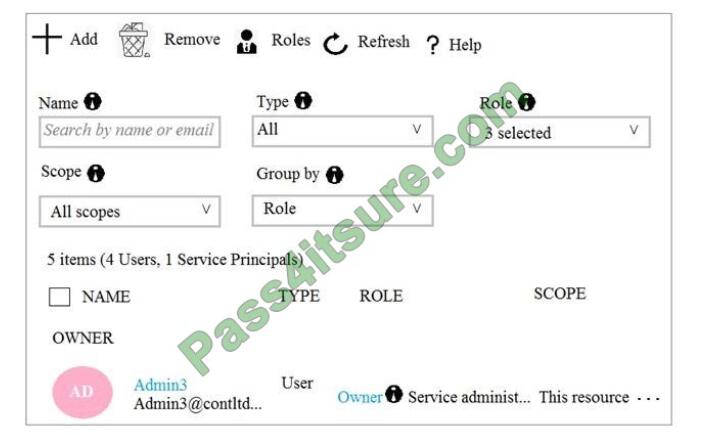
You sign in to the Azure portal as Admin1 and configure the tenant as shown in the Tenant exhibit. (Click the Exhibit
tab.)
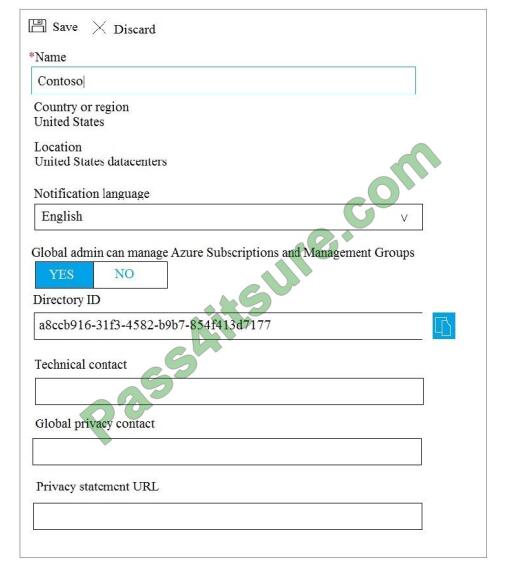
For each of the following statements, select Yes if the statement is true. Otherwise, select No.
NOTE: Each correct selection is worth one point.
Hot Area:
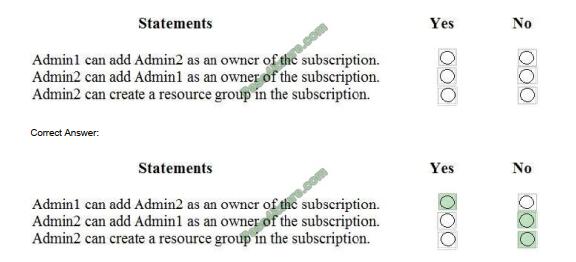
QUESTION 3 #
You have an Azure subscription that contains a policy-based virtual network gateway named GW1 and a virtual network
named VNet1.
You need to ensure that you can configure a point-to-site connection from VNet1 to an on-premises computer.
Which two actions should you perform? Each correct answer presents part of the solution.
NOTE: Each correct selection is worth one point.
A. Add a service endpoint to VNet1.
B. Add a public IP address space to VNet1.
C. Create a route-based virtual network gateway.
D. Reset GW1.
E. Delete GW1.
F. Add a connection to GW1.
Correct Answer: CE
QUESTION 4 #
You have an application named App1 that does not support Azure Active Directory (Azure AD) authentication.
You need to ensure that App1 can send messages to an Azure Service Bus queue. The solution must prevent Appl from
listening to the queue.
What should you do?
A. Modify the locks of the Queue
B. Configure Access control (IAM) for the Service Bus
C. Configure Access control (IAM) for the queue.
D. Add a shared access policy to the queue
Correct Answer: D
There are two ways to authenticate and authorize access to Azure Service Bus resources: Azure Activity Directory
(Azure AD) and Shared Access Signatures (SAS). Each Service Bus namespace and each Service Bus entity has a
Shared Access Authorization policy is made up of rules.
QUESTION 5 #
You have an Azure subscription named Subscription1. Subscription1 contains the resource groups in the following
table. RG1 has a web app named WebApp1. WebApp1 is located in West Europe.

You move WebApp1 to RG2.
What is the effect of the move?
A. The App Service plan for WebApp1 moves to North Europe. Policy1 applies to WebApp1.
B. The App Service plan for WebApp1 remains in West Europe. Policy1 applies to WebApp1.
C. The App Service plan for WebApp1 moves to North Europe. Policy2 applies to WebApp1.
D. The App Service plan for WebApp1 remains in West Europe. Policy2 applies to WebApp1.
Correct Answer: D
You can move an app to another App Service plan, as long as the source plan and the target plan are in the same
resource group and geographical region. The region in which your app runs in the region of the App Service plan it\\’s in.
However, you cannot change an App Service plan\\’s region.
References: https://docs.microsoft.com/en-us/azure/app-service/app-service-plan-manage
QUESTION 6 #
You have an Azure subscription that contains a resource group named RG1. RG1 contains 100 virtual machines.
Your company has three cost centers named Manufacturing, Sales, and Finance.
You need to associate each virtual machine to a specific cost center.
What should you do?
A. Add an extension to the virtual machines
B. Modify the inventory settings of the virtual machine
C. Assign tags to the virtual machines
D. Configure locks for the virtual machine
Correct Answer: C
References: https://docs.microsoft.com/en-us/azure/billing/billing-getting-started
https://docs.microsoft.com/en-us/azure/azure-resource-manager/resource-group-using-tags
QUESTION 7 #
You have a server named Server1 that runs Windows Server 2019. Server1 is a container host.
You plan to create a container image.
You create the following instructions in a text editor.
FROM mcr.microsoft.com/windows/servercore:lts2019
LABEL maintainer=”[email protected]” RUN dism.exe /online /enable-feature /all /featurename:iis-webserver
/norestart RUN echo “Hello World!” > c:\inetpub\wwwroot\index.HTML
You need to be able to automate the container image created by using the instructions. To which file should you save
the instructions?
A. dockerconfig.json
B. Dockerfile
C. daemon.json
D. Build.ini
Correct Answer: B
The Dockerfile is a text file that contains the instructions needed to create a new container image.
Reference: https://docs.microsoft.com/en-us/virtualization/windowscontainers/manage-docker/manage-windowsdockerfile
QUESTION 8 #
You have the virtual machines shown in the following table.

You deploy an Azure bastion named Bastion1 to VNET1. To which virtual machines can you connect by using
Bastion1?
A. VM1 only
B. VM1 and VM2 only
C. VM2 and VM3 only
D. VM1, VM2, and VM3
Correct Answer: C
QUESTION 9 #
You have an Azure App Service app.
You need to implement tracing for the app. The tracing information must include the following:
1. Usage trends
2. AJAX call responses
3. Page load speed by browser
4. Server and browser exceptions
What should you do?
A. Configure IIS logging in Azure Log Analytics.
B. Configure a connection monitor in Azure Network Watcher.
C. Configure custom logs in Azure Log Analytics.
D. Enable the Azure Application Insights site extension.
Correct Answer: D
For web pages, Application Insights JavaScript SDK automatically collects AJAX calls as dependencies. Note: Some of
the things you can track or collect are:
What are the most popular web pages in your application, at what time of day and where is that traffic coming from?
Dependency rates or response times and failure rates to find out if there\’s an external service that\’s causing
performance issues on your app, maybe a user is using a portal to get through to your application and there are
response time issues going through there for instance.
Exceptions for both server and browser information, as well as page views and
load performance from the end users\’ side.
QUESTION 10 #
Your company has an office in Seattle.
You have an Azure subscription that contains a virtual network named VNET1.
You create a site-to-site VPN between the Seattle office and VNET1.
VNET1 contains the subnets shown in the following table.

A. a route for Subnet1 That uses the virtual network gateway as the next hop
B. a route for GatewaySubnet that uses the virtual network gateway as the next hop
C. a route for GatewaySubnet that uses the local network gateway as the next hop
D. a route for Subnet1 that uses The local network gateway as the next hop
Correct Answer: B
A route with the 0.0.0.0/0 address prefix instructs Azure how to route traffic destined for an IP address that is not within
the address prefix of any other route in a subnet\\’s route table.
When a subnet is created, Azure creates a default route
to the 0.0.0.0/0 address prefix, with the Internet next hop type. We need to create a custom route in Azure to use a
virtual network gateway in the Seattle office as the next hop.
References: https://docs.microsoft.com/en-us/azure/virtual-network/virtual-networks-udr-overview
QUESTION 11 #
A company is migrating an existing on-premises third-party website to Azure. The website is stateless.
The company does not have access to the source code for the website.
They have the original installer.
The number of visitors to the website varies throughout the year. The on-premises infrastructure was resized to
accommodate peaks but the extra capacity was not used.
You need to implement a virtual machine scale set instance.
What should you do?
A. Use an autoscale setting with an unlimited maximum number of instances.
B. Use an autoscale setting to scale instances vertically.
C. Use only default diagnostics metrics to trigger autoscaling.
D. Use an autoscale setting to define one or more profiles that have one or more autoscale rules.
Correct Answer: D
With Azure Monitor, you can auto-scale by a custom metric for Virtual Machine Scale Sets.
Note: By default, Resource Manager-based Virtual Machines and Virtual Machine Scale Sets emit basic (host-level)
metrics. In addition,
when you configure diagnostics data collection for an Azure VM and VMSS, the Azure diagnostic
extension also emits guest-OS performance counters (commonly known as “guest-OS metrics”). You use all these
metrics in autoscale rules.
Note 2: In-guest VM metrics with the Azure diagnostics extension
The Azure diagnostics extension is an agent that runs inside a VM instance. The agent monitors and saves
performance metrics to Azure storage.
These performance metrics contain more detailed information about the status of
the VM, such as AverageReadTime for disks or PercentIdleTime for CPU. You can create autoscale rules based on a more
detailed awareness of the VM performance, not just the percentage of CPU usage or memory consumption.
Reference:
https://docs.microsoft.com/en-us/azure/azure-monitor/platform/autoscale-custom-metric
https://docs.microsoft.com/en-us/azure/azure-monitor/platform/autoscale-common-metrics
QUESTION 12 #
Note: This question is part of series of questions that present the same scenario. Each question in the series contains a
unique solution that might meet the stated goals. Some question sets might have more than one correct solution, while
others might not have a correct solution.
After you answer a question in this section, you will NOT be able to return to it. As a result, these questions will not
appear in the review screen.
You have an Azure Active Directory (Azure AD) tenant named Adatum and an Azure subscription named Subscription1.
Adam contains a group named Developers. Subscription1 contains a resource group named Dev.
You need to provide the Developers group with the ability to create Azure logic apps in the Dev resource group.
Solution: On Subscription1, you assign the DevTest Labs User role to the Developers group.
Does this meet the goal?
A. Yes
B. No
Correct Answer: B
The DevTest Labs User role lets you connect, start, restart, and shut down your virtual machines in your Azure DevTest
Labs.
References: https://docs.microsoft.com/en-us/azure/role-based-access-control/built-in-roles#devtest-labs-user
QUESTION 13 #
You have two Azure Active Directory (Azure AD) tenants named contoso.com and fabrikam.com.
You have a Microsoft account that you use to sign in to both tenants.
You need to configure the default sign-in tenant for the Azure portal.
What following action should you do?
A. From the Azure portal, change the directory.
B. From the Azure portal, configure the portal settings.
C. From Azure Cloud Shell, run Set-AzureRmContext.
D. From Azure Cloud Shell, run Set-AzureRmSubscription.
Correct Answer: A
QUESTION 14 #
You have an app named App1 that reads messages from an Azure Service Bus queue. App1 has the following
requirements:
1. Messages must be processed in the order in which they are received.
2. No message is to remain in a Service Bus queue named Queue1 for longer than 14 days.
3. Messages that cannot be delivered must be retained until they are reviewed, and then manually deleted.
You need to create Queue1.
Which two settings should you modify for Queue1? To answer, select the appropriate settings in the answer area.
NOTE: Each correct selection is worth one point.
Hot Area:
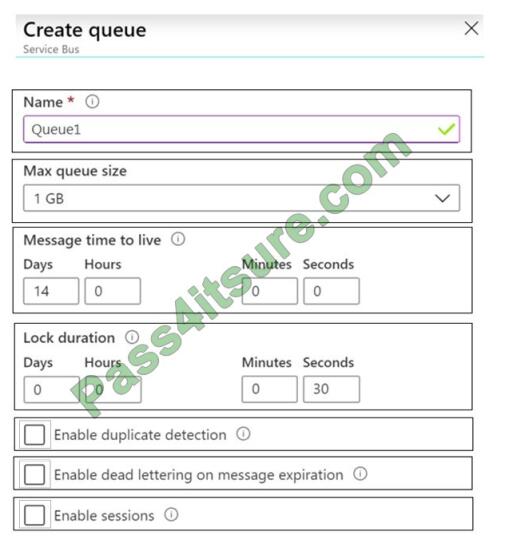
Correct Answer:
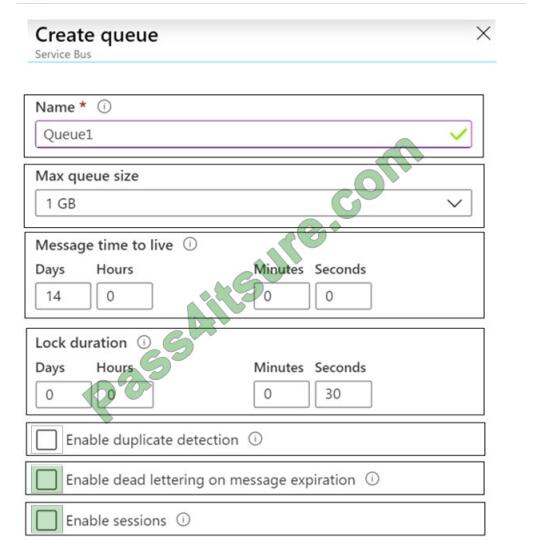
Enable dead lettering on message expiration
Expired messages can optionally be moved to a dead-letter queue by setting the
EnableDeadLetteringOnMessageExpiration property, or checking the respective box in the portal. If the option is left
disabled, expired messages are dropped.
Note: The purpose of the dead-letter queue is to hold messages that can\’t be delivered to any receiver, or messages
that couldn\’t be processed. Messages can then be removed from the DLQ and inspected.
An application might, with the help of an operator, correct issues and resubmit the message, log the fact that there was an error and take corrective action.
Enable sessions
The session feature in Service Bus enables a specific receive operation, in the form of MessageSession in the C# and
Java APIs.
You enable the feature by setting the required session property on the queue or subscription via Azure
Resource Manager, or by setting the flag in the portal. It\’s required before you attempt to use the related API
operations.
Reference:
https://docs.microsoft.com/en-us/azure/service-bus-messaging/service-bus-dead-letter-queues
QUESTION 15 #
You have an Azure App Service named WebApp1.
You plan to add a WebJob named WebJob1 to WebApp1.
You need to ensure that WebJob1 is triggered every 15 minutes.
What should you do?
A. Change the Web. config file to include the 1-31 1-12 1-7 0/15 CRON expression
B. From the properties of WebJob1, change the CRON expression to 0/15**. C. Add a file named Settings. job to the ZIP file that contains the WebJob script. Add the 1-31 1-12 1-7 0/15* CRON
expression to the JOB file
D. Create an Azure Automation account and add a schedule to the account. Set the recurrence for the schedule
Correct Answer: B
You can enter a CRON expression in the portal or include settings. job file at the root of your WebJob .zip file, as in the
following example:
{ “schedule”: “0 */15 * * * *” }
References: https://docs.microsoft.com/en-us/azure/app-service/webjobs-create
Remember to hold on, don’t check the answer yet, do it by yourself! Only in this way can you effectively improve your comprehensive ability!
The free Microsoft AZ-303 exam questions and answers are part of the Pass4itSure AZ-303 exam dumps questions and answers.
Summarize
It is easy to understand: Pass4itSure AZ-303 dumps can help you successfully pass the Microsoft AZ-303 exam, of course, this also requires you to study and practice exam questions seriously! It doesn’t mean this, you don’t have to do anything. Understand! Come get real-time updates,
Complete Microsoft AZ-303 exam questions and answers https://www.pass4itsure.com/az-303.html (total questions: 480 questions and answers). Help you pass smoothly.